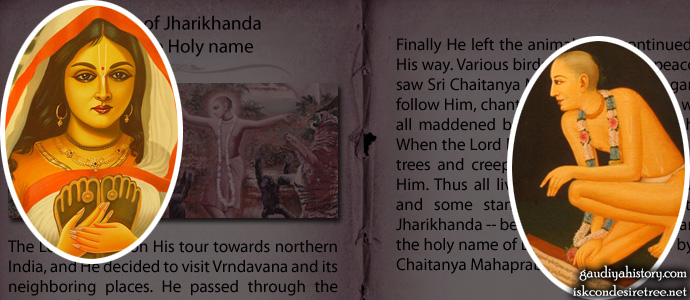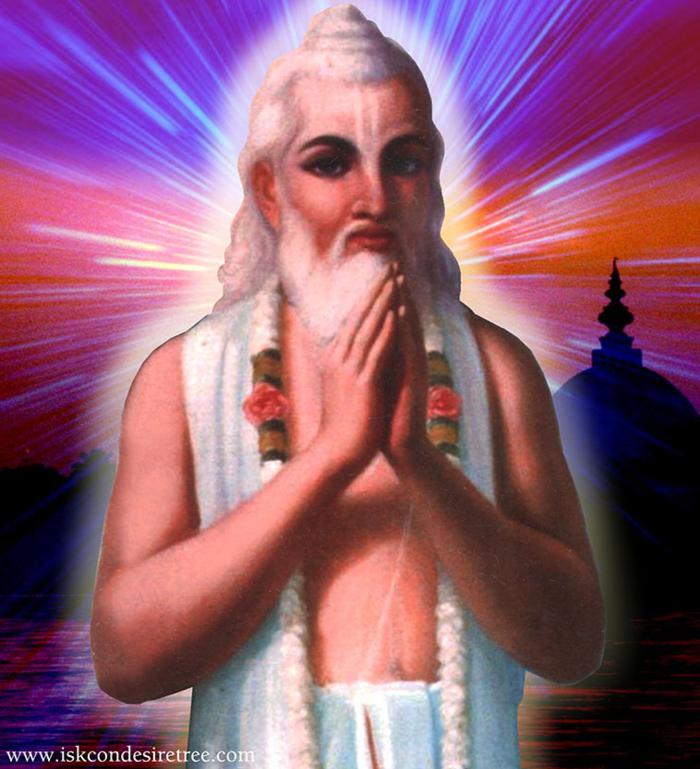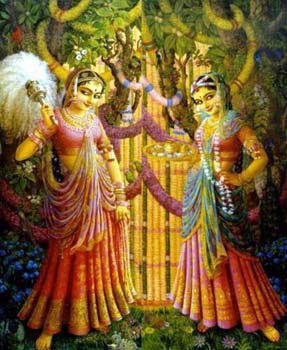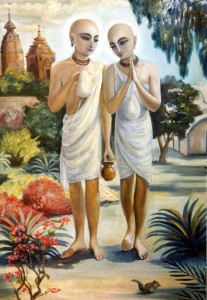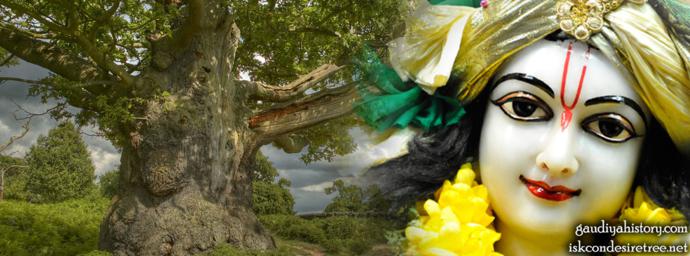
That Lord Nityananda is also non-differnent from Lord Sankarshana is described in the following statement of the Shri Chaitanya-chandradaya-nataka: "Lord Nityananda Avadhuta is non-different from Lord Sankarshana."..."Lord Nityananda Avadhuta is actually the Personality of Godhead Lord Balarama. Always staying among the Devotees, He shines with the splendor of thousands of suns." (In the wallpaper: from left to right Lord Shri Balarama, Shri Nityananda Prabhu, ISKCON Chennai).
Shankararanya was the sannyasa name of Shrila Vishvarupa, who was the elder brother of Shri Chaitanya Mahaprabhu. At young age he left home and took sanyas. He left his body in Pandarapura.
sankararanya—acarya-vrksera eka sakha
mukunda, kasinatha, rudra—upasakha lekha
(C.C.1.10.106)
The acharya Shankararanya was considered the forty-eighth branch of the original tree. From Him proceeded the subbranches known as Mukunda, Kashinatha and Rudra.
Shrila Prabhupada writes in the purport:
It is said that Shankararanya was the sannyasa name of Shrila Vishvarupa, who was the elder brother of Vishvambhara (the original name of Shri Chaitanya Mahaprabhu). Shankararanya expired in 1432 Sakabda (A.D. 1510) at Sholapur, where there is a place of pilgrimage known as Pandarapura. This is referred to in the Madhya-lila, Chapter Nine, verses 299 and 300.
Lord Chaitanya hears about the passing away of Shankararanya
tanra eka yogya putra kariyache sannyasa
‘sankararanya’ nama tanra alpa vayasa
(C.C.2.9.299)
Shri Ranga Puri also remembered that one of her (Sachimata) deserving sons had accepted the renounced order at a very young age. His name was Shankararanya.
ei tirthe sankararanyera siddhi-prapti haila
prastave sri-ranga-puri eteka kahila
(C.C.1.9.300)
Shri Ranga Puri informed Shri Chaitanya Mahaprabhu that the sannyasi named Shankararanya had attained perfection in that holy place, Pandarapura.
Shrila Prabhupada writes in the purport:
Shri Chaitanya Mahaprabhu’s elder brother was named Vishvarupa. He left home before Shri Chaitanya Mahaprabhu and accepted the sannyasa order under the name of Shankararanya Swami. He traveled all over the country and finally went to Pandarapura, where He passed away after attaining perfection. In other words, He entered the spiritual world after giving up His mortal body at Pandarapura. Shri Ranga Puri, a disciple of Shri Madhavendra Puri and Godbrother of Isvhara Puri, disclosed this important news to Shri Chaitanya Mahaprabhu.
There is a description in Chaitanya Bhagavata Adi Khanda Ch 7:
Text 67
In name only did Vishvarupa go home. He quickly returned to Advaita's house.
Text 68
Material happiness did not bring pleasure to Vishvarupa's heart, where the bliss of Krishna-kirtana always stayed.
Text 69
When He was home, Vishvarupa stayed always in the room that was a Vishnu Temple. He hardly ever went to the other rooms.
Text 70
When His parents began to make plans for His marriage, Vishvarupa became very unhappy at heart.
Text 71
"I must renounce the world", Vishvarupa decided in His heart. "I must go to the forest", was the only thought in His heart. It kept Him awake at night.
Text 72
Only the Supreme Personality of Godhead can truly understand the desires that stay in the Supreme Personality of Godhead's heart. After a few day Vishvarupa accepted sannyasa.
Text 73
In this world He was known by the name "Shankararanya". The best of the Vaishnavas, He walked on the path that leads to the limitless Supreme Person.

The Lord and His parents loudly wept. Tormented by separation from His brother, Lord Chaitanya fell unconscious...Jagannatha Mishra's home became filled with weeping.(In the wallpaper: crying person, and leaving person).
Text 74
When saintly Vishvarupa left, the hearts of Sachi and Jagannatha Mishra burst into flames.
Text 75
The Lord and His parents loudly wept. Tormented by separation from His brother, Lord Chaitanya fell unconscious.
Text 76
I do not have the power to place on my mouth words that describe that torment of separation. Jagannatha Mishra's home became filled with weeping.
Text 77
Seeing that Vishvarupa had accepted sannyasa, Advaita and the other Vaishnavas wept again and again.
Text 78
When they heard this news, the upper-class and middle-class non-devotees did not respond in the same way. Hearing this news, they were not overcome with grief.
Text 79
Their hearts broken, Sachi and Jagannatha Mishra cried, "Vishvarupa! Vishvarupa!"
Text 80
Jagannatha Mishra was overcome with grief for his son. His relatives and friends tried to console him.
Text 81
They said, "O Jagannatha Mishra, please be peaceful. Don't be unhappy at heart. Your son is a great soul who has brought liberation to His entire family.
Text 82
"When a person accepts sannyasa, then sixty-million of His family members go to live in Vaikuntha.
Text 83
"By acting in this way, your son has attained the perfection of knowledge.
Text 84
"You should be very happy." Speaking these words, everyone grasped the hands and feet of Sachi and Jagannatha Mishra.
Text 85
They said, "Your Vishvambhara is the ornament of the family. This son will continue your dynasty.
Text 86
"He will destroy all your sufferings. How can ten millions sons in compare this son?"
Text 87
All the relatives and friends explained the truth in this way. Still Jagannatha Mishra's suffering did not break.
Text 88
Thinking of these instructions, Jagannatha Mishra became peaceful. Then, when he remembered Vishvarupa's virtues, he forgot all about being peaceful.
Text 89
Jagannatha Mishra said, "In my heart I do not know whether this son will stay home.
Text 90
"Lord Krishna gave me a son, and then Lord Krishna took Him away. Whatever Lord Krishnachandra wishes will certainly be.
Text 91
"Independent of You, the individual soul has not even a half mustard seed's worth of power. O Lord Krishna, I dedicate my body and senses to You. I take shelter of You."
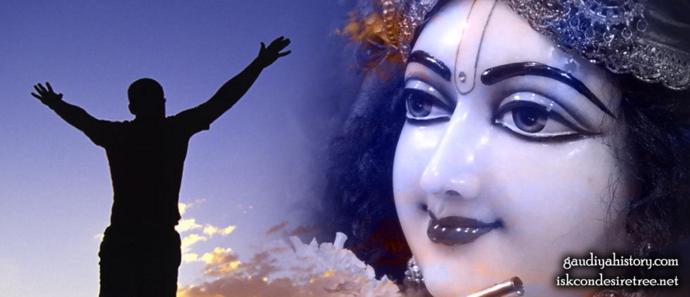
"Independent of You, the individual soul has not even a half mustard seed's worth of power. O Lord Krishna, I dedicate my body and senses to You. I take shelter of You." (In the wallpaper: Shri Krishna, ISKCON Chennai, a man).
Text 92
With this knowledge of jnana-yoga, little by little saintly Jagannatha Mishra became peaceful and steady in his thoughts.
Text 93
In this way Vishvarupa left home. His form is not different from the form of Lord Nityananda.
Text 94
Whoever hears this description of Lord Vishvarupa's sannyasa attains Krishna-bhakti (devotional service to Lord Krishna). For him the noose of karma is cut.
Text 95
When they heard of Vishvarupa's sannyasa, the Devotees felt both joy and sorrow at every moment.
In Shri Gaura Ganoddesha Dipika, Kavi Karnapura describes:
58
The original form of the Supreme Lord is considered not different from the Lord's direct expansions. For this reason it is considered that Lord Chaitanya Mahaprabhu, the son of Shrimati Sachi-devi, is non-different from His expansion Lord Vasudeva, the first member of the Chatur-vyuha. In the same way Shri Vishvarupa is considered non-different from the incarnation Lord Sankarshana, the second member of the Chatur-vyuha.
59
Lord Nityananda Avadhuta is also said to be non-different from Lord Sankarshana. That Shri Vishvarupa is identical with Lord Sankarshana is described in the Shri Chaitanya-chandrodaya-nataka, where Kali says to Dharma the following words:
60
"Lord Chaitanya's elder brother Vishvarupa is identical with the Personality of Godhead Lord Sankarshana. Vishvarupa never married, but accepted the order of parivrajakacharya-sannyasa and left home. It was the transcendental glory of Shri Vishvarupa that caused Lord Chaitanya to accept spiritual initiation from Ishvara Puri."
61
That Lord Nityananda is also non-differnent from Lord Sankarshana is described in the following statement of the Shri Chaitanya-chandradaya-nataka: "Lord Nityananda Avadhuta is non-different from Lord Sankarshana."
62
When the eternal Personality of Godhead Lord Vishvarupa disappeared from home, He entered the body of Lord Nityananda Avadhuta.
63
My father, Shivananda Sena, once said: "Lord Nityananda Avadhuta is actually the Personality of Godhead Lord Balarama. Always staying among the Devotees, He shines with the splendor of thousands of suns." Saying this, he began to dance.
We find references of Vishvambhara in Chaitanya Mangala by Shri Lochana Das Thakur:
Vishvarupa, the older brother of Vishvambhara, was a precocious student and he quickly learned all the Vedas. Who can explain the greatness of Nimai's brother?
Vishvarupa Takes Sannyasa
I shall now describe a conversation between Murari Gupta and Damodara Pandita.
Damodara Pandita asked Murari Gupta, "Where has Vishvarupa, Nimai's elder brother, gone?"
Murari replied, "Listen to me, great Pandita Damodara. I will tell you whatever I know. Vishvambhara, the abode of good qualities, quickly learned all the scriptures. He's expert in all brahminical duties. He affectionately serves His parents. He is fully conversant with Vedanta, the essence of all religion. He does nothing but devotional service to Lord Vishnu. He is dear to everyone. He has achieved all perfections, yet within His heart He stays completely detached and fixed in the Absolute Truth.
"Vishvarupa, the son of Jagannatha Mishra, held the shastras in his left hand and discussed Krishna-katha with his classmates. One day while walking home, Jagannatha Mishra saw this and thought, 'Now, my young beautiful son is eighteen years old and ready for marriage. I should make arrangements for Vishvarupa's marriage.'
"Noticing his father' s meditative mood, Vishvarupa thought, 'it seems my father is thinking about my marriage, but I shouldn't get married. Of course, this might upset my mother.' The next day at dawn, Vishvarupa clasped his manuscripts and left home forever. He swam across the Ganges and took sannyasa.
"At midday there was still no sign of Vishvampa. Jagannatha and Sachidevi searched every house in Navadwipa, but couldn't find their son. The neighbors whispered among themselves about Vishvarupa's taking sannyasa. When Jagannatha Mishra and Sachidevi heard this, they both fainted unconscious on the ground. The three words, appeared full of darkness.
"Sachidevi cried out, 'O my son Vishvarupa! Come home, I want to see you. Why did you leave everything? How will your beautiful delicate body and tender feet tolerate the hardship of walking far and wide? You can't tolerate the slightest pain for even a moment. To whom will you present your insistent demands? When you were studying, you couldn't concentrate on your lessons. 'I can't go anywhere without thinking of you. When I take a bath, my mind is disturbed with the thought that you may return at any time. When I hear you calling "Mother" I forget everything else; for that sound is my greatest treasure. Seeing your sweet face, I no longer think of myself. I don't know what kind of suffering has caused you to neglect me and accept sannyasa.
'O my husband, go search for Vishvarupa and bring him back to me. Let the people say whatever they want, but bring back my son again. I shall perform his sacred thread ceremony.'
"Trying to pacify his bereaved wife, Jagannatha Mishra said, 'Please listen Sachidevi, don't lament. The whole material existence is false like a dream. Your son Vishvarupa is a great personality. By accepting sannyasa at such an early age, he will bring fortune to our family. Please bless him so he can remain fixed in his sannyasa vow, and progress steadily on the path of devotional service. Don't lament for his welfare. If a member of the family takes sannyasa, he benefits many generations of that family. So, our son has done a wonderful thing.' "Damodara, in this way Jagannatha and Sachidevi consoled each other. This concludes the story of Vishvarupa's sannyasa."
Lochana Dasa says that at that time Vishvambhara was sitting on Sachimata's lap and gazing at His father's face. Vishvambhara said, "Father, it doesn't matter where My brother, Vishvarupa, has gone. Don't worry, I will look after you." On hearing this, Jagannatha Mishra and Sachidevi lovingly embraced Nimai and forgot their miseries.
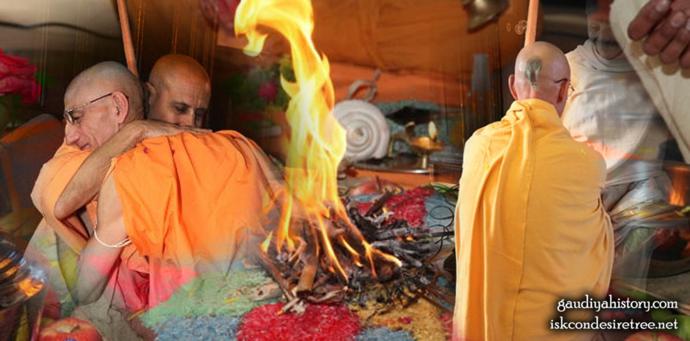
'Please listen Sachidevi, don't lament. The whole material existence is false like a dream. Your son Vishvarupa is a great personality. By accepting sannyasa at such an early age, he will bring fortune to our family. Please bless him so he can remain fixed in his sannyasa vow, and progress steadily on the path of devotional service. Don't lament for his welfare. If a member of the family takes sannyasa, he benefits many generations of that family. So, our son has done a wonderful thing.' (In the wallpaper: Sannyasa initiation fire sacrifice).
